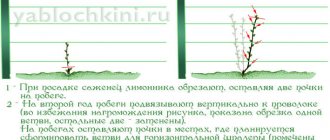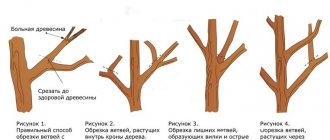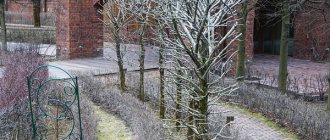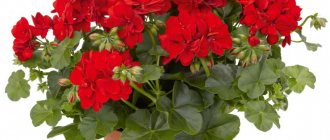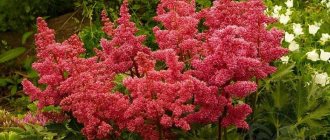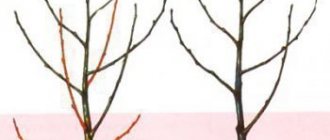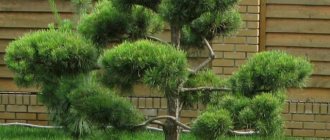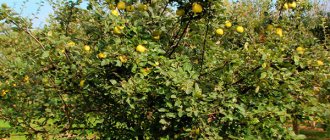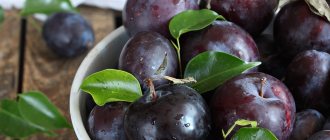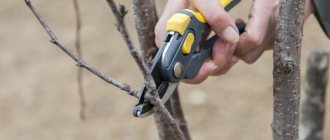Pruning cherry plum in spring
One of the components of cherry plum care is pruning, which not only helps the formation of its crown, but also helps to increase the yield and lifespan. This process is very important for the tree, so anyone who wants to feast on these fruits should become familiar with when and how to do it.
How to prune cherry plum?
It is best to prune cherry plums in mid-spring (late March - April), before the buds bloom. Due to the fact that the sap flow through the tree during this period will still be weak, the wounds will heal faster. Pruning is carried out annually; depending on the age of the tree, only the number of branches removed changes.
The most important goal that should be achieved as a result of pruning is the correct arrangement of branches. To do this, those that grow close to each other, touch, or simply become too long are removed. In this case, it is imperative to cut out all diseased and dry branches to prevent the spread of the disease throughout the tree.
The crown of the cherry plum can be shaped like a bush or a low tree. In the first case, it will only be necessary to thin out the crown and shorten the shoots. In the second, first (the first 3-4 years) a sparse-tiered crown is formed, and then it will only be necessary to maintain its shape. It is recommended to make the main branches (there should be 5-7 pieces) at a height of 75-80 cm from ground level.
Good illumination of the crown, obtained by annual pruning, is very important for hybrid varieties of cherry plum, such as the large-fruited “Kuban Comet” or “Sarmatka”. This is due to the fact that when the branches thicken, the fruits become small and sometimes even noticeably change color.
When pruning cherry plum, it is necessary to take into account that with strong pruning it begins to grow faster, so this method can only be used on weakly growing trees or branches.
womanadvice.ru
What you will need for the procedure
To properly trim the cherry plum, you need to prepare all the tools for the work in advance.
Required set of tools:
- pruner;
- gardening scissors;
- garden saw;
- gloves;
- loppers;
- garden hacksaw.
All tools that are planned to be used to trim cherry plum branches must be sharpened in advance. For cutting, use only sharply sharpened tools that do not leave creases on the branches.
Pests and diseases that are dangerous to cherry plum seedlings and methods of combating them
When is it better to prune apple trees in autumn or spring?
The main ailments to which cherry plum is susceptible include:
Hole spot, which appears as brown spots on the foliage. The affected tissue falls out and holes form in the foliage. A small dirty red spot deforms the leaf and gradually affects the branches, to which the spots spread, leading to cracking of the bark. Gum begins to emerge from the cracks that appear. To combat the disease, it is necessary to burn all the foliage that has fallen in the fall. Treatment with 1% Bordeaux mixture will help fight the disease. In case of severe damage, it is recommended to re-treat 21 days before the start of harvest. For preventive purposes, cherry plum can be sprayed with 3% iron sulfate (until the moment it begins to bloom) and the crown should not be allowed to thicken. The milky sheen differs from other ailments by the silvery coating on the cherry plum leaf. There is a true milky sheen and a false one. The false form can appear against the background of freezing of the tree in winter. To restore the plant, it is enough to care for it, water it and fertilize it in spring and summer. Real milky shine is a fungal disease that penetrates deep into the wood and provokes the occurrence of stem rot. Towards mid-July, the foliage turns brown and begins to dry out. To combat a fungal disease, affected branches must be removed and destroyed. The resulting cut should be treated with a 1% solution of copper sulfate and garden pitch. For preventive purposes, it is advisable to spray trees with preparations that contain copper in the spring and summer. Planting trunks must be treated with lime. Gray rot, covering the surface of the fruit with gray pads that contain fungal spores. Branches and shoots quickly begin to turn brown and wither, and growths appear on the surface of the bark. To avoid infection, it is necessary to systematically inspect the trees and remove diseased fruits from the branches. Before the buds begin to bloom, it is recommended to treat the cherry plum with Bordeaux mixture. Marsupial disease is a fungal disease of cherry plum, which prevents the formation of bones in the fruit. At the same time, the cherry plum grows, becomes deformed and becomes covered with a powdery coating. The flesh becomes wrinkled and greenish. All shoots that have been affected begin to bend and swell
When a disease occurs, it is very important to promptly get rid of diseased fruits and shoots. Coccomycosis begins to develop in early June. The upper part of the foliage is covered with red-brown spots
Gradually they begin to merge with each other, and the lower part of the leaf suffers from a powdery pinkish coating. The foliage turns yellow and falls prematurely. The fruits dry out before reaching full ripening. For prevention purposes, it is important to burn leaves collected from under trees. In early April, cherry plum must be treated with Hom. Any gardening store will tell you which product is best to use in a particular situation.
In addition to diseases, cherry plums can also be affected by pests. The most common damage to the plant is brown fruit mites, slimy sawfly and oriental codling moth. Why does the cherry plum drop its fruits? The cause may be a codling moth that spoils the harvest. In order to protect the tree from these pests, it will be necessary to periodically clean the trunk of dead bark and carry out treatments with drugs such as Karate or Fufanon
In autumn, it is important to completely collect all the leaves from the area and burn them. Undoubtedly, the process of growing cherry plum is quite difficult.
However, by following the recommendations of experts and taking care of the seedlings, you can grow a healthy and fruitful tree, which will delight you with a hefty harvest and its beauty for many years.
Tools and materials for work
Before starting to work with wood, prepare the following tools and materials:
- pruner,
- garden saws,
- budding knife,
- sharpening stones, whetstones,
- twine for spreading and securing branches,
- wooden forks for branches,
- garden pitch or oil paint (copper sulfate, clay) for treating wood wounds.
- Wooden supports for branches.
You can buy garden varnish at any gardening store. Or cook it yourself.
Cherry
Pruning rowan in spring, autumn and summer in 2021
Rice. 1. Pruning bush-type cherries. Cherry plants are divided into bush-like and tree-like. Bush cherries reach a height of 2-4 m, form a spherical crown with drooping branches, and form shoots from the roots.
Fruiting is concentrated mainly on annual growths of the previous year (few bouquet branches are formed). This type of fruiting leads to rapid exposure of the branches. The lifespan of trees is 15-20 years.
Tree cherries are trees 5 m or more in height with a clearly defined trunk and skeletal branches. They live up to 30 years. They are characterized by a mixed type of fruiting - approximately 50% of the harvest is formed on last year's annual shoots, the second half - on bouquet branches. The latter are formations 0.5-1 cm long with greatly shortened internodes. 1-2 growth buds are laid at the ends, and 4-10 flower buds on the sides. They bear fruit within 3-4 years. Then fruiting decreases, and after 7-8 years they die off.
In cherries, two types of simple buds are formed in the leaf axils - vegetative and generative (flowering). Along with single ones, groups of two or three buds are also formed. Conventionally, three types of annual shoots are distinguished: growth shoots over 40-50 cm long with vegetative buds; mixed (20-40 cm), bearing both types of buds, and short (up to 20 cm) with lateral flowering and terminal vegetative buds.
Cherry trees usually form a tiered or sparsely tiered crown shape. Formation is completed 4-5 years after planting. In the crown of bushy cherries, 7-12 branches are left as skeletal branches (tiered crown), in tree-like ones - 5-6 (sparsely tiered). During the formation of trees, shortening the terminal growths of skeletal branches should be avoided, as this will increase branching and lead to excessive thickening of the crown.
Pruning of young trees over the next few years consists mainly of thinning the crown. In this case, first of all, all crowns growing inward, intertwining, poorly located in space and hanging branches and shoots, as well as branches that form dangerous forks, are removed.
Rice. 2. Tree-type cherry pruning. With age, the length of annual growths in plants significantly decreases, the branches lengthen and become bare. When the length of the shoots of the continuation of the skeletal branches becomes less than 25-30 cm, begin anti-aging pruning. Depending on the amount of growth, the age of the trees and the degree of exposure, all skeletal and most of the semi-skeletal branches are shortened by 2-5-year-old wood by transferring them to healthy, well-growing and conveniently located lateral branches and strong bouquet branches. Of the annual shoots, only strong shoots of the top type are shortened in order to limit their length and change the direction of growth. The center of the crown is lightened by cutting out the central conductor above a strong lateral branch located at a convenient height accepted for this crown shape.
Anti-aging pruning enhances the growth of all branches and stimulates the germination of bouquet branches, weak non-fruiting branches and dormant buds into shoots. As a result of such pruning, the size of the crown decreases, its stability increases, and plant productivity increases. The effect of rejuvenating pruning on trees has a positive effect over the next 3-4 years. After this period, it is repeated, and in the intervening years they are limited to only sanitary pruning.
When pruning, you should avoid causing a large number of large wounds on the central conductor and at the base of skeletal branches, as this can aggravate freezing of the trees and lead to severe gum disease.
How to fertilize in the fall
- 10 kg of organic matter (humus, compost)
- 100 g potassium
- 200 g superphosphate
All of the listed fertilizers are mixed and applied once in September-October in the tree trunk circle, 50 cm away from the plant. Cherry plum feeding in the fall is done in October.
In the first decade after planting, the cherry plum gives intensive growth, its lateral buds easily awaken, and the tops grow quickly. Therefore, cherry plum is widely used for decorative landscaping; its crown can be given any fancy shape. Abrosculptures are formed on the cherry plum.
Trim
cherry plum is best harvested
in the spring
. Cherry plum is prone to severe thickening of the crown, which also negatively affects the yield. Therefore, caring for cherry plums necessarily includes annual pruning in the spring.
Trimming Features
- Cherry plum bears fruit on last year's growths, fruit branches and spurs.
- Most fruits are produced on annual shoots.
Therefore, shortening annual growth will reduce the yield
All attention should be paid to thinning the crown. Excess shoots, as well as poorly located crowns directed inward, must be removed
Each fruiting branch should be well illuminated by the sun.
When pruning cherry plums in the spring, shoots longer than 50 cm are slightly shortened. At the same time, numerous side branches immediately form on them. If they thicken the crown too much, then you can pinch them back in the summer until the beginning of July.
Description of culture
Irga planting and care pruning. What makes Irga sick? Pruning and formation of an adult bush
Breeders have bred many species that differ in fruit color, size and taste, which can take root in the Moscow region and central Russia.
Botanical characteristics:
- grows as a tree or deciduous shrub;
- belongs to the Rosaceae family of the genus Plum;
- trunk height - 2-13 m, thickness - up to 50 cm;
- inflorescences are white and pink, arranged solitary and in pairs on the branches;
- some varieties have thorns on the branches;
- flowering period - mainly May, duration - 8-10 days;
- fruit shape - round, oval, weight on average 15 g (large-fruited varieties - up to 80 g).
Cherry plum rarely tastes like a plum; each variety of the crop has its own flavor note, which can be sweet or sour.
Cherry plum seedlings
To systematize their work, breeders identified five main varieties of cherry plum from the variety of trees:
- Syrian;
- spread out;
- Caspian;
- Iranian;
- Fergana
In comparison with garden plum varieties, cherry plum has the following advantages:
- increased resistance to drought;
- unpretentiousness to maintenance, soil composition;
- rapid ripening of the tree, readiness to bear fruit, starting from the second season;
- long productive period (30-50 years);
- ability to bear fruit annually;
- long life cycle.
Among other things, the plant is a good honey plant. Cherry plum is used in the confectionery industry to make jam, juice and marshmallows.
Disadvantages of the culture include sensitivity to low temperatures and a high rate of self-infertility.
Reference! The fruits of cherry plum have a unique composition, enriched with valuable microelements. Because of this, they have long been used in folk medicine.
Chemical composition and calorie content of cherry plum
Ripe cherry plum fruits contain 4-5% sugar, organic acids, pectin substances, and vitamins. The combination of all these substances in them is very successful, thanks to which both fresh fruits and various seasonings prepared from them contribute to the absorption of meat and fat by the body.
It is interesting that the chemical composition of cherry plum fruits is to a certain extent related to the color of the fruit: yellow-fruited forms have a particularly high content of sugar and citric acid and almost no tannins, and chokeberry cherry plums are distinguished by a high content of pectins.
Cherry plum seeds are also beneficial. From them they produce oil similar in composition to almond oil - up to 41-43% of its weight in the seeds (not counting the shell). Cherry plum oil, like almond oil, contains the glycoside amygdalin (calorifier), which has the ability to decompose into glucose, benzoaldehyde and hydrocyanic acid in the presence of water and the emulsin enzyme.
The fruits of the cherry plum are tasty, sweet and sour, used fresh and in canned form (compote, syrups, jam, marmalade, jelly, oriental marshmallow-lavash made from sun-dried puree from mashed plums, marmalade, juice, wine). They are the main component of Tkemali sauce.
The essence for lemonades is made from cherry plum juice. In the Caucasus, lavash made from the pulp of cherry plum fruit is popular. It is stored for a long time, has a pleasant taste, is valued as a nutritious and dietary product, and prevents the development of scurvy.
Unripe cherry plum fruits also have a more prosaic, but also important, area of application. They contain a lot of citric acid - up to 14% of dry weight, and it is quite easy to extract it. Therefore, green cherry plum fruits serve as a source of cheap citric acid.
Sanitary pruning
An important part of caring for an adult cherry plum tree. In spring or late autumn after leaf fall, you need to trim off all old and damaged branches. In each case, do not forget to cover the wounds with garden varnish. Mode everything that grows vertically down or rubs together. A properly formed tree has 4-6 large skeletal branches growing in the desired shape. There should be a distance of at least 50 cm between the tiers. The main mode is a third, the side mode is 5 buds.
Approximately once every 5-7 years, the tree is rejuvenated by cutting off dead branches and allowing new ones to grow. Don't forget to disinfect the tool.
By the age of 7, the cherry plum will begin to produce a lot of fruits.
Therefore, at this time it is important that it is not dense in the central part. Also, when purchasing a seedling, be sure to check the cherry plum variety to find out its characteristics.
So, there are medium, tall and short varieties that require appropriate pruning. If you follow all the rules, you will be guaranteed delicious fruits for many years.
Video of pruning cherry plum tree in spring
Are you having trouble finding a specific video? Then this page will help you find the movie you need. We will easily process your requests and give you all the results. No matter what you are interested in and what you are looking for, we will easily find the necessary video, no matter what direction it would be.
If you are interested in modern news, we are ready to offer you the most current news reports in all directions. The results of football matches, political events or global, global problems. You will always be aware of all the events, if you use our wonderful search. The awareness of the videos we provide and their quality depends not on us, but on those who flooded them into the Internet. We just supply you with what you seek and require. In any case, using our search, you will know all the news in the world.
However, the world economy is also quite an interesting topic, which worries very many. A lot of things depend on the economic state of different countries. For example, import and export, any food or technology. The same standard of living directly depends on the state of the country, as well as wages and so on. What can be useful for this information? It will help you not only to adapt to the consequences, but also to warn against a trip to this or that country. If you are an avid traveler, then make sure to use our search.
Today it is very difficult to understand political intrigues and to understand the situation you need to find and compare a lot of different information. Therefore, we will easily find for you various speeches of the deputies of the State Duma and their statements for all the past years. You can easily understand the politics and the situation in the political arena. The policy of different countries will become clear to you and you can easily prepare yourself for the coming changes or adapt already in our realities.
However, you can find here not only various news from around the world. You can also easily find yourself a film, which will be nice to watch in the evening with a bottle of beer or popcorn. In our search database there are films for every taste and color, you can easily find an interesting picture for yourself without any problems. We can easily find for you even the oldest and hard-to-find works, as well as the classics known to all - for example Star Wars: The Empire Strikes Back.
If you just want to rest a bit and are looking for funny videos, then we can quench your thirst. We will find for you a million different entertainment videos from around the planet. Short jokes easily lift your spirits and another day will cheer you up. Using a convenient search system, you can find exactly what will make you laugh.
As you already understood, we work tirelessly, that you would always receive exactly what you need. We created this wonderful search specifically for you, that you could find the necessary information in the form of a video clip and watch it on a convenient player.
Features and recommendations for pruning
Pruning cherry plums of various varieties depends on the ability of the variety to form replacement branches and on the desire of the gardener. Cherry plum can be formed in the form of a tree or in the form of a bush, if the variety has a high vegetative capacity.
In trees of winter-hardy varieties, the lower tier of branches is formed according to a pattern at a height of up to 60 cm; for weakly winter-hardy varieties, it is better to form them lower to the ground for the best chance of a successful wintering.
It is preferable to form the cherry plum varieties Kubanskaya, Sonetka, Peach, Zlato Scythians, and July Rose in the form of a bowl. Solnechnaya, Tsarskaya, Gek, Lama, Gift to St. Petersburg develop well with a pyramidal type of crown. Their conductor is cut out when they reach a height of 2-2.5 m.
Using the rules for pruning cherry plums, you can work with plums, almonds and peaches, since these are the closest related crops.
Pruning the columnar cherry plum comes down to removing the branches that grow on the main conductor in different directions. If they are not cut off, the colonoid will take on an irregular shape and begin to grow.
Pruning hybrid cherry plum comes down to maintaining sufficient illumination of the crown. The growths of a plant of this variety grow quite quickly and can reach a length of up to 1 m. Therefore, they need to be trimmed to 40-60 cm. This way you will not allow the branches to be exposed, which occurs due to the gradual shift of the fruiting and growth zone to the periphery.
Spring pruning of Kuban comet cherry plum is very important. After all, this variety is valued for its special taste and size of fruits. Without timely pruning, their quality will deteriorate, they will become smaller and their color will fade.
If after reading this article you have a lot of questions, or you still don’t understand how to delete branches, contact the specialists of our website, they will prompt and tell you everything. We provide a variety of garden care services at affordable prices. You can contact us at the indicated telephone numbers.
Cherry plum has many varieties - Kuban Comet, Columnar, Nesmeyana, Cleopatra, Traveler, Skoroplodnaya and others, which differ not only in the taste of the fruit, but also in other characteristics. Therefore, they require a different approach to pruning shoots.
- Columnar requires the removal of shoots growing on the main conductor and extending in different directions. This method of pruning will improve the yield the following year and prevent the overgrowth that is typical of this variety.
- Kuban Comet. Pruning is necessary to ensure high yields, since if there are a large number of dry twigs and shoots, the cherry plum fruits will become smaller and have a less saturated color.
- Hybrid. Shortening shoots is necessary to ensure good illumination, since even small shoots can reach more than one meter in length in one season.
This crop has tree-like, bushy and hybrid varieties. They all require pruning, but for each species the crown must be formed differently, since they have different strength and growth rates of shoots, and the fruits are formed on peripheral or main shoots of different ages. This individual approach to the pruning process distinguishes cherry plum from other fruit crops.
Pruning cherry plums occurs not only to form the crown. Proper pruning should regulate the number of fruits and even influence its quality. If you know how to prune a tree correctly, you can protect it from many diseases, rejuvenate it, and continue the fruiting period. Therefore, before cutting the cherry plum, you need to know exactly the goals and the best timing for this important agricultural activity.
Most gardeners believe that the main pruning should be done in early spring, before the buds have yet opened. This is the time when pruning will be most painless for the plant. In summer, the tree actively grows, accumulating in its leaves the useful substances it needs for life. Pruning shoots in summer causes painful wounds and deprives the tree of these reserves accumulated for the future.
In the fall, sanitary pruning is carried out, dry, damaged, diseased branches are removed, which can become a breeding ground for pests or diseases. Non-fruit-bearing branches that direct their growth downward and sink to the ground are removed. But there are varieties of cherry plum, the main pruning of which is recommended to be done in the fall or at the end of summer, for example, “Kuban Comet”. In winter, pruning is not carried out - the branches, fragile and brittle due to the effects of frost, then take a long time to heal, and it would be difficult to follow the pruning scheme with such material.
Tree cherry plum has tall varieties, reaching 8 - 9 meters ("Beauty", "Iona", "Cultural Yellow"), medium-growing varieties, growing up to 7 meters ("Zelenka Rannyaya", "Cultural Red"), low-growing - up to 4 - 5 meters (“Ashtarak” and its hybrids). All of them form fruits on 8-9 year old overgrowing shoots.
Bush cherry plum bears fruit on one-year-old branches, on 1 - 2-year-old fruit wood, and after 3 - 4 years the fruiting is transferred to the sides if pruning is carried out incorrectly. The bush-like cherry plum produces much more shoots than the tree-like cherry plum; its crown thickens more quickly, although its varieties differ in the length of the shoots. Common varieties: “Lyusha”, “Beauty”, “Pionerka”, “Purpurovaya”.
The varieties of the hybrid group (“Pobeda”, “Strawberry”, “Kuban Comet”) do not differ in strong growth, the shape of the crown is flat-round, since the central conductor itself is “lost”, that is, moves to the side at a young age. Fruits are formed on annual growth and on 1-2 year old bouquet branches.
Based on these different abilities for fruit formation, growth rate and the emergence of new shoots, cherry plums of different varieties are pruned.
If the crown of the tree is columnar, then you need to promptly remove the shoots that form on the central conductor. In hybrid cherry plum, its cup-shaped crown is maintained by timely (constant) thinning of branches.
Proper pruning is very important, since the formation of the crown brings the onset of the fruiting period closer, and subsequent pruning regulates the quality and quantity of the harvest.
When new shoots stop growing on an old tree, at the beginning of spring the old skeletal branches are cut down, and the cut areas are carefully cleaned and covered with garden varnish. New shoots soon form at the cutting site, of which only 3 or 4 of the strongest are left, the rest are removed in mid-summer.
Please note: it is not recommended to trim a large number of old branches at the same time. Otherwise, the tree will not survive such severe stress and will die. It is better to spread out anti-aging pruning over 2-3 years.
As a rule, all types of pruning are performed in one procedure. In other words, old, non-fruit-bearing branches are immediately removed, the crown is formed, and, if necessary, thinning is also carried out. Spring pruning should be done in late April or early May.
Columnar
Stage-by-stage work
So we planted a cherry plum seedling - for the first year of its life it is not recommended to prune it so that it takes root well and does not disappear.
In the first years of the tree’s life, select the branches that will be the main ones in the skeleton, cut off the center or leave it. Depending on the type of pruning. This will form the first skeletal row. The next year you will move on to the next one, and so gradually by 5-6 years the skeleton of the tree should be fully formed, and all that remains is to cut off the interfering or diseased branches.
Usually they are cut 50 cm from the base so that second-order branches appear on these branches. If it turns out like this. If the main branches are shorter than 50 cm, they are cut into thirds. And the main part of the pruning is postponed for another year.
If you need to make a flattened crown, then the second branch, which grows higher than the first, needs to be shortened at the same level in that one. And shorten the central part by 30 cm. You will receive another group of branches in the 3rd year of life and the form will be almost ready. All you have to do is maintain the tree in order and carry out annual sanitary pruning.
Cherry plum branches grow quite quickly. So no need to worry. If you cut off more than necessary, new ones will definitely grow.
Nuances of the formation of individual varieties
The pattern of crown formation depends on the variety of cherry plum. Trees are tree-like, bush-like, hybrid and columnar. Before you start pruning, it is important to study the specifics of carrying out work on each type.
Tree-like
Most of the crop grows on 7-9 year old shoots. Therefore, it is recommended to cut branches only inside the crown. In this case, dry, damaged and downward growing branches are cut down. Then you should shorten specimens with highly branched and weakly branched shoots. If the annual growth is less than 50 cm, then the cherry plum is not shortened.
With a significant decrease in the growth of branches, shortening is carried out on 2-3-year-old wood. And if it stops completely, then at 5-6 years old.
Upon reaching the age of 25, rejuvenating pruning of the cherry plum is carried out. This procedure is carried out on old trees in lean years, since the cherry plum will recover for several years after it.
Bush-like
On bushy varieties, fruits appear on annual shoots. As a rule, these varieties do not require pruning for the first 3-4 years after planting the seedling. If you do not prune the plant, fruiting goes to the branches growing on the periphery. If the procedure has not been carried out for too long and the tree is completely overgrown, then the formation of the crown takes place in stages over 2-3 years. First, thin out the crown and remove dry and damaged branches. Then, next year, some of the shoots are shortened.
Hybrid
Hybrid varieties are characterized by the fact that they produce abundant growth per year. Approximately up to 1 m per fruiting season, so such varieties will have to be pruned most often, almost annually. Every spring the crown is thinned out, leaving a few skeletal branches. Deformed, weak branches with the fewest shoots are cut down. Thinning allows access to sunlight to those branches that constantly bear fruit.
If you do not thin out the crown, the yield gradually drops, the fruits become smaller and taste sour. As soon as the yield begins to decline and the fruit begins to taste sour, the branches are thinned. It is usually carried out on 2-3 year old wood. If the annual growth is not rapid, then at 5-6 years.
Columnar
The purpose of pruning branches on columnar varieties is to remove some of the shoots on the main conductor. This measure will help reduce the growth of annual growth of branches and improve the quality of cherry plum yield. It is important to properly cut off unnecessary branches. To carry out the procedure, use only well-sharpened pruning shears. This rule applies to pruning on all types of trees. If you use a blunt sector, creases will remain on the cuts, and this can lead to the spread of diseases.
Selection of seedlings
When choosing a cherry plum seedling, preference should be given to young plants (ideally one-year-old). The survival rate of three-year-olds is low. Hybrid varieties bred by modern breeders are considered worthy options. They have strong immunity, can withstand severe frosts and drought, and bear fruit consistently.
Cherry plum Gek
Criteria for a good seedling:
- closed root system;
- age - no more than 1-1.5 years;
- modern hybrid;
- dormant buds on branches;
- white root section.
Reference! The exposed root shoots of cherry plum dry out quickly. After planting the tree in open sun and strong winds, it will most likely die.
The interval between purchasing a seedling and planting it should be reduced as much as possible. If this is not possible, then it is recommended to place the plant in a container with water. During transportation, the rhizome should be wrapped in a well-moistened cloth. Upon arrival at the landing site, you can temporarily bury the trunk in the shade, placing it at an angle. The soil should cover 1/3 of the entire length of the tree. In this state, the cherry plum is sometimes left to overwinter if weather conditions suddenly deteriorate in the fall. But in the spring, before the buds bloom, the seedling is transplanted to a permanent place. With the buds in full bloom, it will not be possible to get a fruitful tree, if it survives at all.
Formation scheme
Forming/pruning cherry plums in summer is an important and necessary manipulation in the process of developing its growth. Competent and systematic implementation of the procedure stimulates good growth of branches and enhances the formation of fruits on skeletal branches
To achieve positive results, it is important to follow all the rules for pruning cherry plum.
The young tree differs from other fruit and berry trees in its active growth, especially in the first years after planting. Therefore, in order to shorten the growth, it needs summer pruning. For cherry plum, summer pruning is the key to a strong and stable crown. The procedure consists of the following steps:
- the branches located below are shortened to the height of a full bud, and the upper sections of the shoots with defective buds are removed;
- the remaining branches, except for the conductor, are shortened to the level of the cut of the lower shoot;
- a pyramidal crown should be formed as follows: cut the conductor 22-25 cm above the rest of the branches, and to form a spreading, wide crown, the conductor is cut off below the branches.
- to form the skeleton of the crown, improperly growing shoots must be cut in an inclined position so that they acquire a “semi-skeletal” position;
- The tree should be pruned until the branches of the young cherry plum are completely formed.
GROWING RUSSIAN CHERRY PLUMS ON STAMP AND SKELETON GROWERS
Some promising varieties of Russian plum, for example, such as Zlato Scythians, July Rose, Seedling of Kakhenta, Cleopatra, are not winter-hardy enough in the conditions of central Russia and freeze strongly in severe winters. To increase their winter hardiness, I recommend growing hybrid cherry plum in cultivation on standard or skeleton-forming trees - trees of highly winter-hardy plum or sloe varieties. We can recommend the Tula black plum, Skorospelka red, Eurasia-43, as well as other local highly winter-hardy varieties (and seedlings) of plum, sloe, and cherry plum.
Our experience demonstrates the effective influence of standard formers on the winter hardiness of Russian plum. In the Michurinsky garden of the Moscow Agricultural Academy in the fall of 1997, 45 annual seedlings of the Russian plum varieties Zlato Scythians, Cleopatra, Timiryazevskaya (control) and 45 annual seedlings of the Tula black plum (standard-former) were planted, onto which 2 years later the same were grafted (using improved copulation). Russian plum varieties (experience). As a result, in the period from 1997 to 2007 (10 years), 2.8 times fewer cherry plum trees on standard-forming trees froze than in the control ones; their condition was better, and the total yield was almost 2 times greater. It follows from this that standard formers help to increase the winter hardiness and productivity of Russian plums, therefore, in places with harsh natural conditions, I recommend using this particular method of cultivation for the most promising varieties: early ones - July Rose and Yarilo; medium - Vladimir Comet and Seedling of Kakhenta; later - Seedling Rocket and Vaneta.
SHAPING AND CUTTING
Russian plum trees, especially young ones, are distinguished by greater shoot-forming ability and vigorous growth of shoots, therefore, during annual pruning, it is necessary to mainly thin out the annual branches that thicken the crown, they are cut into a ring, and strong branches are shortened as early as possible
This is done very carefully, since too much pruning can lead to even greater formation of shoots and, as a result, greater thickening
With the help of annual competent pruning and shaping of trees, they try to create a small-sized crown with a height of up to 2.5-3 m, a width of up to 2-2.5 m. This crown shape will facilitate harvesting, tree care, and will also contribute to annual yield and fruit production good quality.
FROST PROTECTION
Russian plum flowers appear 5-7 days earlier than domestic plum flowers (in early May), so the risk of them being exposed to spring frosts is greater.
Recommendations for smoking gardens and spraying trees with water are ineffective, so I advise using a covering system. To do this, at the beginning of flowering, you need to sprinkle the trees with honey (to attract pollinating insects), and before frost, cover the tree crown first with fabric (burlap, sheet, spunbond, etc.), and then with agril film. Just don’t forget to leave a few gaps on the sides for insects to fly in.
Such a shelter will not only save the flowers from severe frosts (up to minus 6°C), but will also improve their pollination, since the air underneath is warmer and more insects attracted by the smell of honey will fly there. Remove the cover at the beginning of the formation of a young ovary, when the danger of frost has passed.
Growing Russian plum as a hardier and less demanding crop is more reliable and more profitable than growing domestic plum, so in places with harsh climatic conditions I recommend everyone to grow this particular crop.
Review of crown formation methods. Cut protection products
The main task that pruning solves is to increase productivity. This is the main technique in crown formation. This process is complemented by other methods of caring for cherry plums. More details about each of them:
| Type of crown formation | Purpose and result of the work |
| Thinning | For uniform lighting and heating of the crown. The upper branches should not shade the lower and neighboring shoots. |
| Shortening | This is especially true in the first years. Many varieties are capable of growing up to 2 m during the growing season. This length is not conducive to fruiting, so the branches are cut so that 1/3 of them remains. |
| Pruning | It differs from shortening in that the ends of long branches are adjusted to allow shoots to grow wider. |
| Pinching | It involves the removal of buds and young shoots, that is, they are simply torn off. This is done with shoots directed into the crown. This work is carried out in the spring before and during bud break. |
| Kerbovka | Sometimes the crown of a young cherry plum looks one-sided. To stimulate the growth of shoots in the foot direction, an incision is made on the trunk or skeletal branch through the cambium to the wood. Thus, the flow of nutrients to the dormant buds is redirected. |
| Banding | A technique that is applied to trees that stop bearing fruit. To reduce the growth of green mass and activate the formation of fruit buds, the tree trunk is tied (compressed) with wire or a thin circular cut is made. At the same time, the outflow of nutrients through the cambium into the root system slows down, which stimulates the activity of fruit buds. |
Kerbovka retains nutrients in the right place, which activates the growth of dormant buds.
When pruning cherry plum and other fruit trees, it is important to adhere to the rules of protecting plants from adverse factors .
Trim time
In fact, the time to prune cherry plums is a personal matter for the gardener. This can be done in spring, autumn and even summer. An important nuance is the temperature regime of your region. It is also worth understanding that each season has its own characteristics. Taking this into account, many gardeners prefer to prune cherry plums in early spring, before sap begins to flow. In late winter, pruning is not carried out due to the fact that the tree is in the dormant stage.
In spring, trees are pruned in the first days after the onset of warm weather. The air temperature can be within 10 degrees. In the southern regions this may be March, in the northern regions it may be the end of April or May. Much also depends on the temperature regime of a particular year. During this period of time, the movement of juice is still very slow. This will allow the wounds to heal faster.
It is not recommended to prune cherry plums in summer, because... the tree is actively growing and produces a lot of sap. At this time, only broken or diseased branches that are mechanically damaged can be cut off.
In the fall, cherry plums are also not often pruned. And if they do this, then only for sanitary purposes. Old and diseased branches that can interfere with the normal growth of the plant are removed. In winter, the tree is also left untouched.
Production of garden varnish substitutes
There are several recipes for preparing garden varnish. Among them is “Var Reshetnikova”. The composition has a soft, viscous consistency at any air temperature. The mixture is easily applied with a brush. To prepare at home, take the ingredients:
- fir resin -100 g,
- yellow wax - 10 g,
- alcohol - 10 g.
Mix wax and resin in a metal container, heat until liquid, let cool slightly. Then pour in the alcohol heated until warm. Mix all ingredients well. The product for processing cuts after pruning cherry plum in summer is ready.
Article Rating
Landing area
Cherry plum is one of the few plants that can be planted on soils with a high level of groundwater. But this indicator should not rise above 1 m. Otherwise, there is a high risk of root rotting.
When choosing a location, preference should be given to a sunny area; in the shade, cherry plum grows and bears fruit poorly, even fertile soil does not help. Does not respect the plant and drafts. Of the cardinal directions, preference is given to the south or southeast side.
Among the periods of the year for planting, it is better to choose spring, but provided that the buds do not have time to open. You need to focus on the weather. After the onset of stable positive air temperatures at night, planting work is carried out no later than 2 weeks. In autumn, the risk of root freezing increases. For a young plant, a change in environment is in itself stressful, and severe frost will leave no chance of survival.
Reference! Cherry plum seedlings sold by nurseries in pots allow replanting at any time during the warm period, even in summer. A closed root system facilitates rapid adaptation to a new environment.
When to prune cherry plum in the fall?
It is necessary to prune the cherry plum in the fall in case of a sanitary procedure. The timing of this type of work falls on the second half of October - early November. This type of work must be completed before the onset of cold weather. It is not recommended to touch trees in winter.
Reproduction of cherry plum
How to propagate cherry plum
Some forms of cherry plum reproduce by seeds, but more often they use vegetative methods - propagation by root suckers, cuttings and grafting. Self-rooted seedlings can be propagated by shoots, root or green cuttings, but green cuttings require a special installation that produces fog, so we will not dwell on it, as well as on the seed method.
With the seed propagation method of cherry plum, the varietal characteristics of the parent plant are not preserved in the seedlings. The seed method is also not used for growing rootstocks, since when propagating cherry plums by grafting, it is better to take plum seedlings of such varieties as Renklod Kolkhozny, Volzhskaya Krasavitsa, Eurasia 21, Vengerka Moskovskaya, as well as damson, apricot, felt cherry and sloe seedlings as winter-hardy rootstocks.
Reproduction of cherry plum by shoots
This method is the easiest to implement. The best material is shoots located at a distance from the mother plant, since such offspring have a well-developed root system, unlike those that grow close to a tree or bush. In early spring, dig up the place where the offspring leaves the root of the tree, and cut off the mother root, retreating 15-20 cm along it towards the tree. The cut place on the tree root should be even, and do not forget to treat it with garden varnish before burying .
The dug up shoots, if they are developed, are planted in a permanent place. If the shoot is small and weak, plant it in well-fertilized loose soil for growing, and when it gets stronger and grows, transplant it to the planned place.
Propagation of cherry plum by root cuttings
Root cuttings are harvested in early spring or autumn from the most productive trees. The roots of young trees are dug up at a distance of 70-100 cm from the trunk, for adults - at a distance of 1-1.5 m. Roots 5-15 mm thick are dug up and cuttings about 15 cm long are cut from them. If you are preparing root cuttings in the fall, fold them in a box with sawdust and store until spring at a temperature of 0-2 ºC.
In the spring, at the beginning of May, the cuttings are planted in loose soil so that the upper end is buried 3 cm, and the lower end even deeper. The distance between root segments in a row is kept within 8-10 cm. The planting area is covered with film, and on sunny days also with burlap. The soil is kept slightly moist. After a month, the film can be removed. Seedlings are grown from root cuttings for one to two years before planting in a permanent place.
Reproduction of cherry plum by grafting
To carry out propagation using this method, it is necessary to have a varietal cutting as a scion and a rootstock - the plant on which the grafting will be carried out. Rootstocks can be grown from shoots or from seeds. You already know how to grow seedlings from shoots. You can grow a rootstock from plum or sloe pits by planting them in moist and loose soil at the end of September.
In the spring, the area with the crops is lightly harrowed, and in May seedlings appear, which are watered all summer, and the soil around them is loosened and weeded. The rootstocks from the seed will be ready for grafting in the summer, in July or August of next year, when sap flow is active in the trees.
Scions are cut on the day of grafting from branches 30-40 cm long, not shorter. Grafting is carried out in several ways: in a T-shaped incision, in the butt, using the method of improved copulation, behind the bark and in the spine.
Before budding, the rootstocks are watered to stimulate sap flow, and the trunk is wiped from dust with a damp sponge. All leaves are removed from the scions, leaving only pieces of petioles 5 mm long, after which the bud with such a petiole is cut off with a sharp knife along with a strip of bark about 3 cm long and at least 5 mm wide. On the rootstock, 3-4 cm above the ground level, make a T-shaped cut, carefully bend the bark at the intersection of the short and long cuts and insert a shield (a bud with a strip of bark) under it, after which the bark is pressed tightly to the wood and the grafting site is tied tape or tape so that the bud itself with the remainder of the petiole is not covered.
Most often, budding is used in the butt, since it is easier to perform and always gives a good result. The method of improved copulation is good when the cutting and rootstock are of the same thickness. If the rootstock is thicker than the scion, the methods of grafting the wood and the bark are recommended.
How to treat cherry plum for diseases
Cherry plum is rarely affected by diseases and pests. But preventive treatment of the crown is mandatory when caring for cherry plums.
Moniliosis or gray mold
The disease manifests itself on cherry plum fruits; they are covered with gray pads in which fungal spores live.
How to treat
- Remove diseased fruits.
- In autumn, destroy dried fruits and fallen leaves.
- In autumn, after leaf fall, spray the crown with Bordeaux mixture (300 g per bucket of water).
Clusterosporiosis or holey leaf spot
In spring, small red spots appear on the leaves of the cherry plum. After 2 weeks, holes form in their place. This is also a fungal disease. When severely damaged, the cherry plum leaves dry out, fall off, the buds turn black, the flowers fall off, and the fruits dry up right on the branch.
How to treat
- Trim damaged branches immediately.
- In the spring, before the buds open, spray with iron sulfate (300 g per bucket).
- After flowering, spray with Bordeaux mixture (100 g per bucket).
- In the fall, collect ALL the fruits and leaves. Burn.
False milky shine
The leaves all over the tree become covered with a gray coating and fall off prematurely. The main causes of damage: freezing of cherry plum in winter and lack of moisture and minerals.
How to treat
- Treat the crown with the following composition: Aktara + Chorus.
- Provide sufficient fertilizer (described above).
- Water regularly, and carry out water-recharging watering in late autumn.
In a year or two the tree will fully recover.
milky shine
Unlike false milky sheen, the disease appears on individual branches. The fungus penetrates the wood and causes stem rot of the cherry plum. Gradually, the disease spreads throughout the tree, the branches dry out.
How to treat
- Immediately cut diseased branches back to healthy parts.
- Treat the cut with copper sulfate (10 g per liter of water).
- For the winter, whiten the trunk and skeletal branches and spray the crown. The composition of whitewash and preparations for spraying are described in detail
Promptly treat frost holes and mechanical damage to the bark with copper sulfate. In early spring, carry out preventive spraying of cherry plums against diseases and pests. How exactly -
Aphid
- Spray with infusion of chamomile, celandine, garlic or onion peel.
- Spray with Aktara or Confidor.
Important: any treatment of cherry plum with chemicals should be carried out 20 days before harvest. Cherry plum grows best on loamy soil with weak acidity, while groundwater should lie at a depth of 1.5 m from the surface of the earth
The plant is propagated by seedlings in the spring. Planting pits are made 60 × 40 cm in size and 70–80 cm deep. In case of depleted soil, the size of the pits is increased - 70 × 50 cm. If the soil is sandy, then a layer of clay 10–15 cm thick is poured onto the bottom of the planting pit. In wet soil, to create For drainage, crushed stone, broken brick or coarse sand are placed at the bottom of the planting hole. The drainage layer is made up to 15 cm thick. The distance between neighboring trees should be 3 m
Cherry plum grows best on loamy soil with weak acidity, while groundwater should lie at a depth of 1.5 m from the surface of the earth. The plant is propagated by seedlings in the spring. Planting pits are made 60 × 40 cm in size and 70–80 cm deep. In case of depleted soil, the size of the pits is increased - 70 × 50 cm. If the soil is sandy, then a layer of clay 10–15 cm thick is poured onto the bottom of the planting pit. In wet soil, to create For drainage, crushed stone, broken brick or coarse sand are placed at the bottom of the planting hole. The drainage layer is made up to 15 cm thick. The distance between neighboring trees should be 3 m.
Fertilizers are added to the planting hole: 20 kg of humus, 140 g of superphosphate, 200 g of potassium chloride or 1 kg of wood ash. If the soil is depleted, then the fertilizer consumption is increased by 20–50%. To reduce high acidity, add up to 1 kg of lime to the pit. When planting, the root collar of the seedling is left 10 cm above ground level. After sprinkling the seedling, the soil is compacted and a hole is formed. The tree is watered with 3-4 buckets of water, after which the soil under it is mulched. Immediately after planting, the seedling is pruned.
Care
Protection from pests and diseases
Cherry plum suffers from diseases such as gray rot (monoliosis), brown spot, smallpox, rust, gum disease.
Brown spot appears on the leaves in the form of spots, the leaves gradually dry out and fall off. Gum discharge appears on already diseased plants. Gray rot affects shoots, which fade over time, the fruits of the tree rot, and in their place a gray growth forms.
With smallpox, various spots appear on the leaves, the color fades instead of green - marbled, the fruits take on a completely different unnatural shape, and ripen ahead of time. A disease such as rust appears on the leaf veins in the form of dark spots, then they fall off, and the tree can die even from a slight frost.
Cherry plum is attacked by insects such as sapwood, western gypsy bark beetle, downy silkworm, and codling moth.
Although cherry plum is considered resistant to various diseases, it is also negatively affected by fungal diseases. This is powdery mildew, monilial burn. To protect the plant, you need to carry out sanitary prevention, i.e. burn and remove infected branches and shoots, keep the trunks clean, remove old bark and infected fruit, rake fallen leaves and get rid of weeds. Wounds on the tree trunk are cleaned and disinfected with a solution of copper sulfate.
Formation of trees
In the first year, after planting, the cherry plum crown is formed. It includes a certain number of skeletal branches, their density, the formation of second and third order branches and trees that bear fruit. When forming the crown of the plant, cuttings are cut, shortened and thinned.
The cherry plum forms four types of crowns - without tiered, sparsely tiered, semi-flat and flat. But other types of crowns are also used - hedges and palmettes. Trees are generally pruned without a tiered crown or a cup-shaped crown.
Cherry plums are pruned in spring, summer, and autumn. But, it is correct and better to prune trees in the spring, before the buds begin to bloom, somewhere in March or April. Removing branches during this period is almost painless. And the sap does not flow from the pruned branches, and they heal faster.
Summer pruning is carried out only when minor corrections are necessary, or for sanitary purposes. Trim dry and unnecessary branches, and those that grow inside the crown.
In autumn, cherry plums are pruned only for sanitary purposes. You don’t have to worry too much that removing excess branches will somehow affect fruiting. Sick and dry branches must be removed, as they can be carriers of pests and insects that can negatively affect the tree can live in them. They cut off drooping branches and those that no longer bear fruit.
In winter, pruning cannot be done. Because of the cold, the shoots become fragile and quickly break, and the wounds take a long time to heal.
Fertilizer
Every year, with the onset of late autumn, organic fertilizers are applied to the cherry plum, approximately half a bucket of humus or compost per 1 m². And in early spring, as soon as the trees fade, and in mid-summer the plant needs urea, it is added to the tree trunk. At the next feeding, potassium sulfate is added, about 30 g. per 1 m².
Watering
Young trees, after planting in the ground and pruning, are watered. The norm for watering one tree is considered to be 4 buckets of water. The next waterings are carried out in spring and early summer, approximately the number of waterings is 3 times.
Winter
In winter, frost has a negative impact on the roots and bark of the tree. The bright sun in winter can cause burns to cherry plums, and winter precipitation in the form of snow or ice on the branches can break them.
The root system is mulched with leaves in late autumn. Mulching is done with half a shovel, hay, sawdust, peat are added - all this is mixed with soil, and wood ash is added, which can protect the tree from fungus and mice.
The tree trunk begins to be mulched before the first frost, earlier is not recommended, as the bark can be trampled and damaged. The first snow is thrown with a shovel on top of the mulch, making a snowdrift as high as possible, which guarantees the harmful effects of frost.
The soil is no longer cultivated until the beginning of September. The application of phosphorus fertilizer can help the tree to survive the winter well; it is applied in August. We should not forget about whitewashing tree trunks, its forks and skeletal shoots. For the winter, the cherry plum is covered with spruce branches and wrapped in burlap.
Tree care after pruning
After cutting, you need to pay attention to care:
- When pruning in summer, trees are watered abundantly with warm water, and to prevent the soil from drying out, the soil around the trunk is mulched with peat or sawdust.
- It is recommended to prune on a cool, cloudy day. It is not advisable to prune branches during rain and for several days after it. The crown must dry before the procedure.
- Immediately after the procedure, the cut sites are treated with garden varnish, which helps prevent the occurrence of fungal and viral diseases. The thickness of the garden pitch should not be less than 5 mm. It is not recommended to use fresh manure, paint or lime for processing.
- It is not recommended to cut off more than 1/3 of all branches at once. This will negatively affect the health of the cherry plum.
After the procedure, mineral and organic fertilizers will help the plant recover faster. The type of fertilizing is selected depending on the growing season. In the fall they use organic ones. In the spring, nitrogenous fertilizers are applied to the soil, and in the summer, phosphorus and potassium fertilizers are applied.
